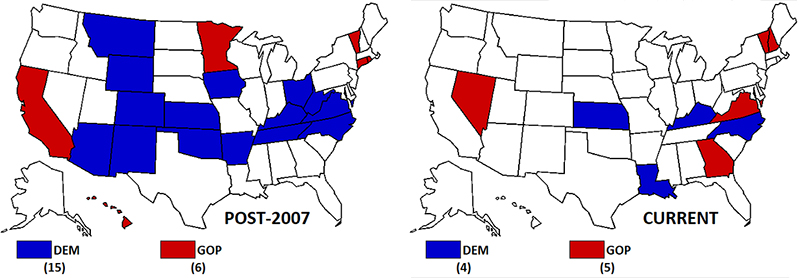

Split-ticket voting is going the way of the dodo. Of the 100 senators, only five caucus with the party that lost the 2020 presidential race in their state. Three of the senators are Democrats: Jon Tester (MT), Sherrod Brown (OH) and Joe Manchin (WV). Two are Republicans: Ron Johnson (WI) and Susan Collins (ME). The small number of crossover senators is a result of the United States' highly polarized politics. After the 2004 election there were 24 and after the 2012 election there were 12. Now it is down to 5.
In the House it is just as bad. Eighteen Republicans are in Biden districts and five Democrats are in Trump districts. This is 23 out of 435 or 5%, the same as the Senate. After the 2004 elections, there were 59 crossover members and in 2012 there were 26. The House can be gerrymandered, but the Senate can't (although the Senate is a gerrymander of the whole country).
Interestingly, the one office where the dodo is hanging on is governorships. Currently, nine states have a governor from the "wrong" party. However, even here the number of crossovers is declining. Compare the gubernatorial crossover maps after the 2007 election and after the 2022 election: There used to be FIFTEEN Democratic governors in what were then red states. Now there are four. And California, Minnesota, Vermont, Massachusetts, and Hawaii all had Republican governors!

Just before the 2022 elections, there were two more crossover governors: Charlie Baker (R) in Massachusetts and Larry Hogan (R) in Maryland.
Some of the governors in the wrong places are vestiges of the past. There used to be Rockefeller Republicans in New England and Democrats in Appalachia. Vermont, New Hampshire, Kentucky, and North Carolina have some of that history left.
How will this history affect the 2023/2024 cycle? If the Republican presidential candidate were to win Arizona, Michigan, Pennsylvania, or Wisconsin, that would create crossover governors there because none of the Democrats in those states are up in this cycle. What about states that are on the ballot?
The open seat in Louisiana is likely to go red this year, putting it back in line with the rest of the state. Republicans would love to knock off Gov. Andy Beshear (D-KY), but he is quite popular in the state and could well hold on. Next year a big test will be the open seat in North Carolina. The Democratic candidate is AG Josh Stein, a standard-issue Democrat. The Republican candidate is the extremely far-right Lt. Gov. Mark Robinson (R-NC). Revulsion at Robinson could end up giving Stein a new job, but most likely the state will go the same way in both the presidential and gubernatorial races. It could be either way, though. A lot depends on turnout.
If Democrats win New Hampshire, as they usually do, that might be enough to elect a Democratic governor as well. There have been plenty of them in the recent past. Further, Gov. Phil Scott (R-VT) hasn't made his plans clear. If he retires, the Democratic candidate will probably win in this very blue state. If Democrats pick up New Hampshire and Vermont, they will have all six governorships in New England for the first time since the Republican Party was founded. If Scott runs, he'll win again, but he might have had enough, just like his neighbor Gov. Chris Sununu (R-NH).
Similarly, if Republicans win Louisiana and Mississippi this year (very likely) and flip North Carolina next year (50-50), then all 11 states of the Confederacy will have Republican governors for the first time in U.S. history. Abraham Lincoln is undoubtedly scratching his head in his grave. (V)